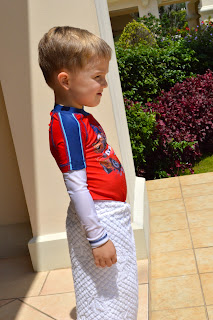Do you know what
Batik is?

Batik is the traditional fabric of Indonesia. You find it EVERYWHERE out here and certain designs can represent different things. Batik shirts range in price from $5 (that's about we paid for Dustin's Batik shirt above) to hundreds of dollars. We recently decided to take a field trip to the Textile Museum (riveting, I know) to learn a little more about Batik. The museum itself was about as exciting as it sounds. Although the fabrics displayed were beautiful, how long can you really spend looking at a bunch of fabric? After our exciting time inside the museum, we were taken to a room behind the museum for a little Batik making of our own! We were the only Westerners in the entire place, but nobody seemed to mind sharing this Indonesian experience with us. Many people there brought their own designs, but we weren't quite that prepared. Lucky for us, they had a huge selection of different designs for us to chose from. We were all a little afraid we were going to have to draw freehand so when they showed us a few of our choices and guided us toward the tracing tables, we all breathed a huge sigh of relief!
 |
| Dustin "helping" Debi trace her flower |
 |
| Emilie also made a flower! |

 |
| Chris & Dustin's tracing of a fish |
After tracing our designs, we were given a quick lesson on using the hot wax. We used these little tools, called cantings, to scoop hot wax into a little copper cup on top of a bamboo handle. We then, tilted the bamboo to apply the hot wax along the lines of our tracings. WOW! THIS TAKES A LOT OF PRACTICE! First, you have to be careful not to spill the hot wax on yourself (Both Emilie and Chris managed to spill on themselves), second, if you tilt the pencil too much, you get splotches. If you tilt it too little, no wax comes out. It takes a steady hand and lots of patience.
Once we finished adding hot wax to the front AND THE BACK of our designs, it was time to dye the material. Lucky for us, there was someone there to do it for us. Our designs were being dyed one color, but most Batik fabrics are dyed in several steps (alternating, wax and dye over and over) with several different colors.
 |
| The first step in the dyeing process was adding a film to help seal the wax. |
 |
| Next, the fabric is rinsed in water, put in the dye and rinsed again. |
 |
| Then, the fabric is added to boiling water to remove the wax. |
 |
| Finally, they are hung out to dry (FYI - the drying process works best when it is not raining so we took ours home to dry). |
Overall, we had an AMAZING time! We have learned to really appreciate the art of Batik making and have added several Batik items to our home including Christmas Ornaments on our tree! If you decide to make the 10,000 mile trek to Jakarta, I can pretty much guarantee you will be dragged to the textile museum to try your hand at Batik making!
 |
| Our Final Products - framed and hanging in our apartment!!! |













































